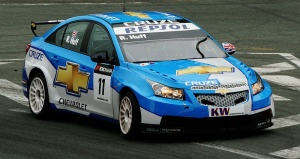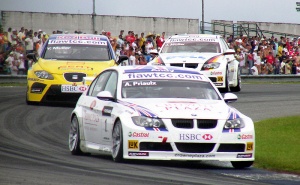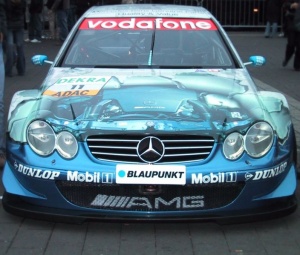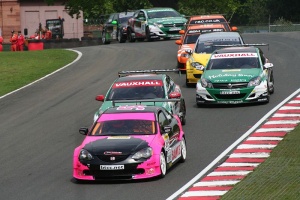Touring car racing
Touring car racing is a general term for a number of distinct auto racing competitions in heavily-modified street cars. It is notably popular in Britain, Germany, Scandinavia, and Australia. It can basically be considered a closed-circuit, sponsored, legal form of street racing performed by professional drivers.
Characteristics of a touring car

While rules vary from country to country, most series require that the competitors start with a standard body shell, but virtually every other component is allowed to be heavily modified for racing, including engines, suspension, brakes, wheels and tires. Aerodynamic aids are usually added to the front and rear of the cars. Regulations are usually designed to limit costs by banning some of the more exotic technologies available (for instance, many series insist on a "control tyre" that all competitors must use) and keep the racing close (sometimes by a "lead trophy" where winning a race requires the winner's car to be heavier for subsequent races).
In this, it shares some similarity with the American stock car racing (governed by NASCAR). However, touring cars are, at least notionally, derived from production cars while today's NASCAR vehicles are based on a shared, custom, design. In the early days of NASCAR, stock cars were in fact built from production cars, whereas some current touring car series are also raced in silhouette racing cars. Touring cars race exclusively on road courses and street circuits, while its American counterpart predominantly utilizes oval tracks, with road courses constituting a small percentage.
Whilst not nearly as fast as Formula One, the similarity of the cars both to each other and to fans' own vehicles makes for entertaining, well-supported racing. The lesser impact of aerodynamics also means that following cars have a much easier time of passing than F1, and the more substantial bodies of the cars makes the occasional nudging for overtaking much more acceptable as part of racing.
As well as short "sprint" races, many touring car series include one or more endurance races, which last anything from 3 to 24 hours and are a test of reliability and pit crews as much as car and driver speed.
Differences between touring cars and sports cars
For the casual observer, there can be a great deal of confusion when it comes to classifying closed-wheel racing cars as 'touring cars' or 'sports cars' (also known as GT cars). In truth, there is often very little technical difference between the two classifications, and nomenclature is often a matter of tradition.
In general, however, touring cars are based upon hatchbacks, saloons or more rarely coupés, while GT racing cars are based upon more powerful and expensive sports cars, such as Ferraris or Lamborghinis. Underneath the bodywork, a touring car is often more closely related to its road-going origins, using many original components and mountings, while a top-flight GT car is often a purpose-built tube-frame racing chassis underneath a cosmetic body shell. Many touring car series, such as the BTCC and the now-defunct JTCC distinguish themselves from sports car racing by featuring front-wheel drive, four-wheel drive and rear-wheel drive cars with smaller engines.
However, while touring cars have a lower technical level than sports cars in general, there are notable exceptions to the rule. The Deutsche Tourenwagen Masters (DTM) is considered to be one of the most technologically advanced racing series in the world, with cars that, underneath their four-door shells, are more purebred racing machines than most FIA-GT vehicles.
Series of competition
DTM
Germany/Europe
The DTM series, the initials standing for Deutsche Tourenwagen Meisterschaft until 1996, then following a hiatus, revived as Deutsche Tourenwagen Masters in 2000, features advanced purpose built V8-powered space frame machines, covered with largely carbon fibre bodyshapes resemblant of the manufacturers' road machine (although the roof and roof pillars do originate from the production car). In order to lower costs, the engine power is limited to 470 hp, and transmissions, brakes and tyres (Dunlop) are standard parts for all. Also, dimension and aerodynamics are equalized. The approx. 1050 kg light DTM cars corner incredibly quickly and wear spectacular bodykits incorporating huge wheel arches and diffusors.
More than 20 works-backed entries of Opel Astra, Audi TT and Mercedes-Benz CLK contested the revived 2000 DTM series but a serious issue developed for the series when Opel pulled out ahead of the 2006 season. The series has survived this hurdle and remained popular with 18 Audi A4 and Mercedes-Benz C-Class contesting the present series.
Nürburgring VLN Endurance racing Series
Germany
Since 1997, and nowadays still on the over 20 km long famous old Nürburgring, in average over 150 touring cars compete in the VLN series of ten typically 4 hour long races. Cars range from old 100 hp road legal compacts to 500 hp Porsche 996 and even modified DTM cars (1250 kg). Most entrants of the 24 Hours Nürburgring collect experience here.
V8 Supercars
Australia and New Zealand
Formerly the Australian Touring Car Championship. The current formula was devised in 1993 (based on Group A regulations) and branded as 'V8 Supercars' in 1997. The series features grids of thirty-one cars with 650+ hp (480 kW). The cars are Ford Falcons and Holden Commodores. The weight limit for a V8 Supercar is 1350 kg. At one time the cars were billed as the "biggest, heaviest, fastest and most powerful" of all touring cars. In terms of outright power, size and weight this is still likely to be true however DTM vehicles are probably faster around a track. However, V8 Supercars provide the closest racing of any touring car category, with the top twenty usually qualifying within one second of one another.
The race cars themselves are derived from production body shells and panels rather than space-frame chassis. Both Holden and Ford financially and technically support their favoured teams and take an active role in promotion of the series.
As the series has grown, major international motorsport organisations have become involved. Several teams now benefit from the involvement of Tom Walkinshaw Racing, Triple Eight Race Engineering and Prodrive. In addition to regular appearances in New Zealand the series ventured to China in 2005 and since 2006 has raced at the Bahrain International Circuit. The growth of the series has seen motorsport equal Rugby League as Australia's third most watched sport.
The series incorporates the famous Bathurst 1000 race as a championship round. Because of the longer distance, regulations require two drivers per car for this race and the Phillip Island 500.
British Touring Car Championship
The British Touring Car Championship (BTCC) currently competes at nine circuits in the UK with cars built either to BTC Touring or Super 2000 specification, with ballast being used to equalise the two types. Cars are 2.0 Litre saloons and hatchbacks with around 270 bhp ({{rnd/cExpression error: Unexpected < operator.decExpression error: Unexpected < operator.|Expression error: Unexpected < operator.|(Expression error: Unrecognized punctuation character "[".)}} kW)Template:Convert/test/Aon and can be front wheel drive, four wheel drive, or rear wheel drive. The last remaining works team Triple Eight was announced to lose support from Vauxhall after the 2009 season. Since BTCC budgets have been kept relatively low, there is a strong independent and privateer presence in the championship. Manufacturers represented by privateers include Volvo, Vauxhall, Chevrolet, Honda, Lexus, BMW, Peugeot, Alfa Romeo and MG.
Prior to 2001 the BTCC was contested by cars built to 2.0 litre supertouring regulations and had in its heyday up to 9 different manufacturers. Joachim Winkelhock stated on several occasions that it was the best touring car championship in the world,Template:Fact and many champions of that era now race in the World Touring Car Championship (WTCC). Between 2002 and 2006 the BTCC ran its own Touring class with Super Production/Super 2000 cars making up the numbers; the Touring class is now being phased out (only privateers are eligible to run old Touring cars) with the intention of a pure Super 2000 series.
World Touring Car Championship

Worldwide Main artical World Touring Car Championship
Modern World Touring Car Championship (WTCC) started in 2005, evolving from the reborn European Touring Car Championship. It is generally considered to be the most prestigious touring car championship in the world.
Running at major international racing facilities, this series is heavily supported by BMW, SEAT and Chevrolet, with Lada also showing limited support. It features 2-litre cars built to Super 2000 regulations based on FIA Group N.
Following the trend of recent FIA rules, cost control is a major theme in the technical regulation. Engines are limited to 2000 cc. Many technologies that have featured in production cars are not allowed, for example: variable valve timing, variable intake geometry, ABS brakes and traction control.
Other series
The Americas
- Argentinian TC2000
- Speed World Challenge
- Castrol Canadian Touring Car Championship
- U.S. Touring Car Championship link
- KONI Challenge Series
- American Touring Car Championship link
Europe
- Germany's ADAC Procar in 2006, former DMSB-Produktionswagen-Meisterschaft (DPM) with ETCC rules
- Swedish Touring Car Championship
- Danish Touring Car Championship
- Italia Superturismo Championship
- Russian Touring Car Championship
- Finnish Touring Car Championship
- Dutch Supercar Challenge
- Castrol-Haugg-Cup (CHC) entry-level series on Germany's Nürburgring
- Gleichmäßigkeitsprüfung (GLP) entry-level series on Germany's Nürburgring
- International Superstars Series
Asia
- Hong Kong Touring Car Championship
- Asian Touring Car Championship
- New Zealand V8s
- Philippine Touring Car Championship (formerly the PNTCC)
- China Touring Car Championship
- Malaysian Super Series
Previous series
- The old World Touring Car Championship, plagued by lack of support from the FIA, raced under the Group A regulations in 1987.
- Germany's former DTC adopted ETCC rules in 2004 and was renamed to DMSB-Produktionswagen-Meisterschaft (DPM) until 2005
- Japanese Touring Car Championship (JTCC) ran from 1994 through 1998.
- Super Tourenwagen Cup (STW) ran from 1994 through 1999.
- North American Touring Car Championship (NATCC) ran from 1996 to 1997.
- South American Super Touring Car Championship ran from 1997 through 2000.
- Norwegian Touring Car Championship
- Championnat de France de Supertourisme (French Touring Car Championship), last season in 2005.
- Campeonato Español de Turismos (Spanish Touring Car Championship) ran from 1959 to 1998.
- Bankfin Touring Car Championship (South African Touring Car Championship)) which ended in 2000.
Other notable competitions
- Spa 24 Hours since 1924
- 24 Hours Nürburgring at the famous old Nürburgring, since 1970, related to VLN series there
- European Touring Car Cup, held at various European circuits since 2005
- Macau Grand Prix Guia Race (contested as part of WTCC since 2005)
- Bathurst 1000 held at Mount Panorama Circuit since 1963 (the race was held at Phillip Island from 1960-1962)
- Tourist Trophy for cars, held until 1988
- Wellington 500, held at the Wellington street circuit between 1985 to 1996
- InterTEC (インターTEC), held at Fuji Speedway as part of the JTCC round through the series duration until the series' demise in 1998
Rule sets
Different sets of regulations do apply:
- Contemporary touring car racing: Group A · Group B · Group F · Group G · Group H · Group N · Group S · Group SE · Group SP · Super 2000 · Supertouring
- Historic touring car racing: Group 1 (racing) · Group 2 (racing) · Group 3 (racing) · Group 4 (racing) · Group 5 (racing)

